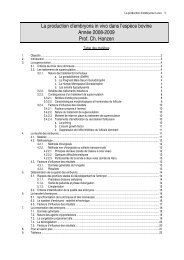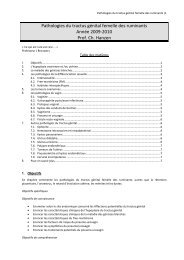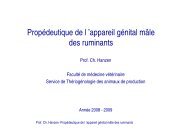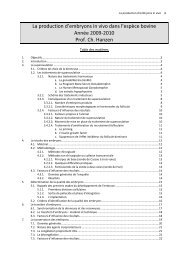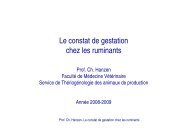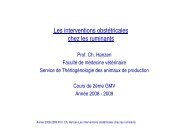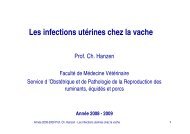La pathologie infectieuse de la glande mammaire Etiopathogénie et ...
La pathologie infectieuse de la glande mammaire Etiopathogénie et ...
La pathologie infectieuse de la glande mammaire Etiopathogénie et ...
Create successful ePaper yourself
Turn your PDF publications into a flip-book with our unique Google optimized e-Paper software.
Pathologie <strong>infectieuse</strong> <strong>de</strong> <strong>la</strong> g<strong>la</strong>n<strong>de</strong> <strong>mammaire</strong>. Approche individuelle. 2<br />
b. Les systèmes immuno-enzymatiques 17<br />
4. Aspects étiologiques <strong>de</strong>s mammites : l’élevage............................................................. 18<br />
4.1. L’instal<strong>la</strong>tion <strong>de</strong> traite ........................................................................................................................19<br />
4.1.1. Le système <strong>de</strong> vi<strong>de</strong> 19<br />
4.1.1.1. <strong>La</strong> pompe à vi<strong>de</strong> 19<br />
4.1.1.2. L’intercepteur 20<br />
4.1.1.3. Le Te <strong>de</strong> contrôle 20<br />
4.1.1.4. <strong>La</strong> canalisation à air principale 21<br />
4.1.1.5. Le réservoir <strong>de</strong> vi<strong>de</strong> 21<br />
4.1.1.6. Le régu<strong>la</strong>teur <strong>de</strong> vi<strong>de</strong> <strong>et</strong> les fluctuations <strong>de</strong> vi<strong>de</strong> 21<br />
a. Fonctions du régu<strong>la</strong>teur 21<br />
b. Les fluctuations longues <strong>de</strong> vi<strong>de</strong> 22<br />
c. les fluctuations cycliques <strong>de</strong> vi<strong>de</strong> 22<br />
d. Les fluctuations acycliques 23<br />
e. Fluctuations brutales 23<br />
4.1.1.7. Le manomètre 23<br />
4.1.1.8. <strong>La</strong> canalisation <strong>de</strong> pulsation (ligne <strong>de</strong> pulsation) 23<br />
4.1.2. Les pulsateurs 24<br />
4.1.3. Le faisceau trayeur 24<br />
4.3.1.1. Caractéristiques techniques 24<br />
4.3.1.2. Le cycle <strong>de</strong> <strong>la</strong> traite 27<br />
4.3.1.3. Le décrochage <strong>de</strong>s faisceaux trayeurs 29<br />
4.1.4. L’acheminement du <strong>la</strong>it vers le tank 29<br />
4.4.1.1. Les tuyaux courts <strong>et</strong> long à <strong>la</strong>it 29<br />
4.4.1.2. Le tuyau long à <strong>la</strong>it 29<br />
4.4.1.3. Le <strong>la</strong>ctoduc 30<br />
4.4.1.4. <strong>La</strong> qualité <strong>de</strong> l’évacuation du <strong>la</strong>it 30<br />
4.4.1.5. Le groupe <strong>de</strong> réception ou unité terminale 31<br />
4.4.1.6. Les accessoires <strong>de</strong> traite 32<br />
a. les compteurs à <strong>la</strong>it 32<br />
b. Le décrochage automatique 32<br />
4.1.5. Le tank à <strong>la</strong>it 33<br />
4.1.6. Les robots <strong>de</strong> traite 33<br />
4.1.7. Le n<strong>et</strong>toyage <strong>de</strong> l’instal<strong>la</strong>tion <strong>de</strong> traite 33<br />
4.1.8. Le contrôle <strong>de</strong> l’instal<strong>la</strong>tion <strong>de</strong> traite 34<br />
4.8.1.1. Testage c<strong>la</strong>ssique 34<br />
4.8.1.2. Testage dynamique ou « humi<strong>de</strong> » 35<br />
4.2. <strong>La</strong> traite ..............................................................................................................................................35<br />
4.2.1. Propr<strong>et</strong>é <strong>de</strong>s mains du trayeur 35<br />
4.2.2. Etablir <strong>et</strong> maintenir un rythme <strong>de</strong> traite dans un environnement non-stressant. 35<br />
4.2.3. Etablir un ordre <strong>de</strong> traite. 36<br />
4.2.4. Préparation du pis <strong>et</strong> <strong>de</strong>s trayons 36<br />
4.4.2.1. Observation 36<br />
4.4.2.2. Elimination <strong>de</strong>s premiers j<strong>et</strong>s 36<br />
4.4.2.3. <strong>La</strong>vage du trayon 36<br />
4.4.2.4. Séchage du trayon 37<br />
4.2.5. Attache <strong>de</strong>s gobel<strong>et</strong>s trayeurs. 37<br />
4.2.6. Temps <strong>de</strong> traite 37<br />
4.6.2.1. Eviter <strong>la</strong> surtraite 37<br />
4.6.2.2. Eviter impérativement l’égouttage (manuel, poids, pierre...) 38<br />
4.2.7. Couper le vi<strong>de</strong> avant d’enlever les manchons : 38<br />
4.2.8. L’hygiène du trayon après <strong>la</strong> traite 38<br />
4.3. Le logement <strong>de</strong>s animaux...................................................................................................................40<br />
4.3.1. Données générales 40<br />
4.3.2. Stabu<strong>la</strong>tion paillée 40<br />
4.3.3. Stabu<strong>la</strong>tion à log<strong>et</strong>tes 41<br />
4.3.4. Stabu<strong>la</strong>tion entravée 41<br />
4.3.5. Le pédiluve 42



